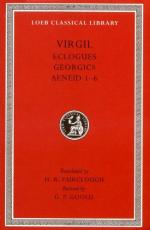|
This section contains 7,780 words (approx. 26 pages at 300 words per page) |

|
SOURCE: “The Unity of the Eclogues: Arcadian Forest, Theocritiean Trees,” Transactions and Proceedings of the American Philological Association, 1967, Vol. 90, pp. 491-508.
In the essay that follows, Van Sickle analyzes the significance of Arcadia in Vergil's Eclogues and argues that it serves as a poetic symbol used to emphasize the unity of the work as a whole.
The idea of a Liber Bucolicorum, the principle of artistic unity by which the Eclogues form a book, is a kind of philosopher's stone of classical scholarship.1 Accounts are legion and contradictory.2 The book itself, however, closes with a representation of the unities of its making: to sit, to weave, and to love a poet (10.70-74). From the Arcadian vantage point of the tenth poem, the poet sees his own work as a whole and gives expression to his own recollective, assiduous, passionate self-consciousness in the symbol of Arcadia. The Arcadian is...
|
This section contains 7,780 words (approx. 26 pages at 300 words per page) |

|


